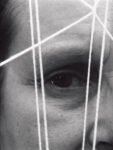There are multiple organisations that teach prisoners skills such as gardening, radio production and literacy, but Fine Cell Work is cut from a different cloth: it’s the only wide-scale British charity and social enterprise to pay offenders an earned income while they’re inside, for work that is done in their cells and in their own time. For 26 years, it has supported over 8,000 individuals to learn needlework, stitching projects ranging from simple bags and bookmarks to holy, wholly impressive 11m-long church kneelers; upmarket upholstery; and tapestries produced in tandem with world-renowned artists such as Cornelia Parker, Gavin Turk and Wolfgang Tillmans.
The movement was founded by Lady Anne Tree, who brokered an arrangement in the 1970s for residents of HMP Holloway to craft two carpets that sold for £10,000 each… but legislation at the time meant stitched-up stitchers couldn’t receive a penny. Irked by the injustice of the rug being pulled from beneath the carpets’ incarcerated creators, Lady Anne battled to change the law, and Fine Cell Work was eventually established in 1997.
Sustainability is locked into Fine Cell Work’s models and morals. It frequently uses second-hand and scrap fabrics, and also offers a service where the charity will finish or repurpose customers’ abandoned sewing projects that would otherwise languish incomplete. Plus, its Open the Gate programme, launched in 2017, helps prison leavers sustain themselves during the often fraught journey from inside to out, by offering structure and community alongside a wage. The darning works darned well: there’s only a 1 percent reoffending rate among participants, against a national average of 46 percent.
The charity’s main focus is on building convicts’ employability while they’re in confinement, then further fostering business abilities after discharge from prison, with the key aim of preventing stitchers from lapsing back into crime. However, Fine Cell Workers frequently speak about how sewing has also taught them qualities which are as important to bolstering their own central sense of humanity as they are useful down at the Jobcentre Plus: a metamorphic means of self-soothing and summoning internal peace, for example, or a reappraisal of their own imagination and who, societally, gets to be creative.
I visited their post-release workshop in Battersea, to hear how the scheme is helping people thread the needle of transitioning successfully to life beyond bars.
I was in a dark place when I joined my first stitching group; now, there is light and brightness
Tania
“Anything you dare to get excited about while you’re inside is always at risk of being dashed away, so you learn not to look to tomorrow at all,” Tania says. “You can only think day by day, to get through.” Yet after joining Fine Cell Work while still incarcerated in 2017, she gradually grew to believe that sewing was something she could literally pin her hopes upon.
“Some of the money I earned from needlepoint went on my canteen, for an extra packet of coffee or some sweets, and I loved that if my son mentioned he was short on cash I had the capacity to help him. But the biggest chunk of my income went into savings to prepare for my release,” she explains.
Upon discharge, prisoners are only given around £70 to live on until systems such as Universal Credit kick in, and significant numbers re-offend because they are unable to get by. “Fine Cell Work helps break that cycle, by giving people an embroidery hoop, a whole new circle of friends and support along with it,” says Tania.
The scheme has deeply enriched Tania’s life beyond material gains, too. She’s working towards her third Open College Network educational certificate, and has a treasured stash of appreciative letters from customers who’ve purchased her pieces; each Fine Cell Work product bears the name of the stitcher who completed it, and buyers are encouraged to send them a note. “It gives your self-belief such a buzz,” Tania reflects. “I always get choked up.”
Not long ago, Tania attended a workshop with textile artist Kaffe Fassett, who encouraged her to become more experimental with her palette. “I’ve been playing with clashing hues and swapping muted tones for vibrant ones, in my décor and dress sense as well as my sewing,” she enthuses. “I was in a dark place when I joined my first stitching group; now, there’s light and brightness.”
Needlecraft gives Tania both zing and Zen; it infuses her with courage, confidence and a means to create cosiness within a hard world. “I like to sew in my comfy chair at home, watching TV with the dogs at my feet,” she smiles.
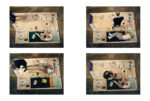
Lee
“I had done some stitching before Fine Cell… but to close up wounds,” says Lee, trimming a remnant of pillarbox-red fabric that used to be part of a coat worn by the Chelsea Pensioners, a 300-strong cohort of elderly British Army veterans who have retired together at the Royal Hospital Chelsea, which dates back to 1692. Uniforms that have been retired themselves are being recycled into dog coats, glasses cases and coasters. “I call those Kevins – like Kevin Costner. Kevin Coaster!” Lee jokes. His accent makes the words sound almost identical, so the pun is nearly as neat as his fastidious needlecraft.
“I really don’t want to sound dramatic, but you know, I see myself in there,” he says, nodding at the pail of scarlet offcuts by his workbench, his tone now hushed and humble. “Others look at people like me as though we belong in the garbage bin. But with the right point of view – and some trust – there are lots of useful things we can become, and many ways we can benefit society.”
Others look at people like me as though we belong in the garbage bin. But with the right point of view, and some trust, there are lots of useful things we can become, and many ways we can benefit society
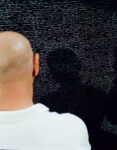
Christopher
If Chris had a personal motto, perhaps it would be “A stitch in time saves nine”. He’s an advanced craftsperson who’s been with Fine Cell Work for a decade, and his work now involves helping to design the kits sent to into prisons.
“I try to foresee issues that might arise when stitchers are sewing in cells by themselves, with nobody to ask, and write troubleshooting tips on the instruction sheets,” he says.
Chris sews in esteemed company: he’s worked on an Ai Weiwei quilt depicting refugees fleeing across the sea, a secret commission from the royal family, and is currently focused on a series of William Morris patterns previously unseen by the public.
It’s not all high art and high society, however; he’s also responsible for helping to refine Fine Cell Work’s immensely popular range of Christmas-tree decorations. “Our founder’s daughter, Isabella Tree, is a conservationist who’s passionate about rewilding land; she reintroduced beavers to her estate in Sussex after
they’d been gone for hundreds of years, so I designed a cute little festive felt beaver to stock in her shop,” Chris says. “Our miniature bears carrying swag bags are a top seller, and we’ve introduced a chef bear with a Christmas pudding on his apron. Originally he was carrying a bag of flour, but we had to remove that because it looked like cocaine.”
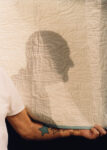
Leonie
“When I first arrived at my AP [approved premises – supervised accommodation for those released from prison but still serving their sentence on licence], I struggled with feeling like I didn’t have a purpose,” says Leonie. “There are only so many times you can pop into town and wander pointlessly round Primark. I ended up staying in bed a lot, depressed, with no reason to get out. Still, anxiety hit me hard when staff suggested I try Fine Cell Work. I’d never even been to London before.”
The team said Leonie didn’t have to arrive at a set hour, which eased the pressure of navigating the cat’s-cradle map and frenetic crowds of the Underground. And once she reached the workshop, she found the combination of methodical, meditative stitching and relaxed, quiet conversation to be profoundly calming – a warm comfort blanket of quilting, and a soft pillow of gentle reintegration into a professional environment.
Standard workplace chit-chat like colleagues asking what you got up to over the weekend can feel jarring and intimidating if your jail sentence means you haven’t had “free time” in a long time, and topics that were par for the course when you were banged up may seem bang out of order in an office. Fine Cell Work’s studios offer a safe space to practise social skills alongside sewing.
Leonie’s new to the crew, but she’s already inspired by the potential of applying abstract, free-flowing concepts to traditional handicrafts. “In prison, officers said they could see what kind of mood I was in through my artwork and drawings,” she says. “Rather than set out with a precise idea of what I want to create, I like to keep things vague and see where they lead themselves.”
Today, though, she’s honing her knowledge by sewing doorstops using deadstock fabric from old sample books. “My partner and sister are both huge advocates for my stitching,” she smiles. “When my perfectionist side comes out and I get frustrated that something I’m making isn’t quite right, they’re like, ‘The fact you’re doing this at all makes it fantastic!’ I should give them ten doorstops each as presents. One for every room.”
No closed doors? Now there’s a gift.
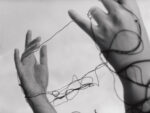
Machines can do incredibly intricate embroidery that would take a human insanely long to complete, but you need a person to come up with the design in the first place. Machines do not have stories like we do
Ron
Ron holds up a cushion he’s made, edged with piping so pristine it’d make an orchestral flautist jealous. A Latin banner is embroidered across the front – Tu ne cede malis, sed contra audentior ito – with the English stitched below: ‘Don’t give in to difficulties, but rather, proceed ever more boldly.’
“The Latin’s a quote from the ancient Roman poet Virgil,” Ron explains. “When I entered it into Google Translate, I got loads of conflicting results, so I emailed Oxford University’s Classics department to get an exact interpretation.” Ron’s a precision guy.
“I’ve always been a problem solver,” he says. “I watch a lot of YouTube tutorials, and I like to find hacks to make the Fine Cell workflow smoother. When I get in the zone, it’s not rare to find me still up at 1.30 in the morning, sewing to Absolute Rock.”
I wonder whether he thinks computerisation and automation have a place in needlework, given their speed and efficiency, or does handicraft sacrifice some soul when it’s not made by hand? “I think there’s an opportunity for melding the two. Machines can do incredibly intricate embroidery that would take a human insanely long to complete, but you need a person to come up with the design in the first place. Machines don’t have stories like we do.”

All names have been changed to protect the
privacy of interviewees.
Special thanks to Vani Krishnaswamy and the Fine Cell Work team.

